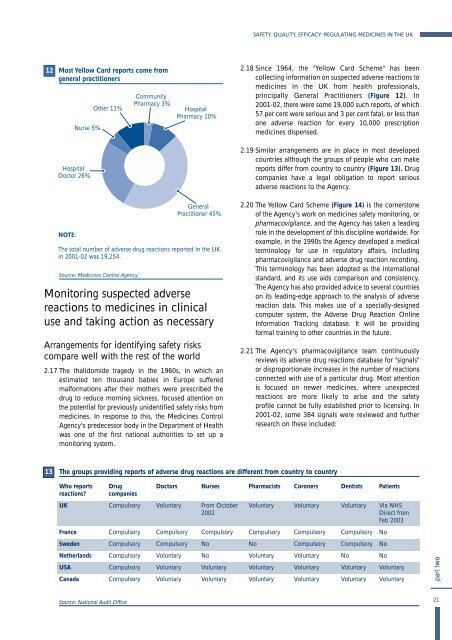Safety, Quality, Efficacy: Regulating Medicines in the UK
Safety, Quality, Efficacy: Regulating Medicines in the UK
Safety, Quality, Efficacy: Regulating Medicines in the UK
- No tags were found...
Create successful ePaper yourself
Turn your PDF publications into a flip-book with our unique Google optimized e-Paper software.
SAFETY, QUALITY, EFFICACY: REGULATING MEDICINES IN THE <strong>UK</strong><br />
12<br />
Most Yellow Card reports come from<br />
general practitioners<br />
Nurse 5%<br />
O<strong>the</strong>r 11%<br />
Community<br />
Pharmacy 3%<br />
Hospital<br />
Pharmacy 10%<br />
2.18 S<strong>in</strong>ce 1964, <strong>the</strong> "Yellow Card Scheme" has been<br />
collect<strong>in</strong>g <strong>in</strong>formation on suspected adverse reactions to<br />
medic<strong>in</strong>es <strong>in</strong> <strong>the</strong> <strong>UK</strong> from health professionals,<br />
pr<strong>in</strong>cipally General Practitioners (Figure 12). In<br />
2001-02, <strong>the</strong>re were some 19,000 such reports, of which<br />
57 per cent were serious and 3 per cent fatal, or less than<br />
one adverse reaction for every 10,000 prescription<br />
medic<strong>in</strong>es dispensed.<br />
Hospital<br />
Doctor 26%<br />
2.19 Similar arrangements are <strong>in</strong> place <strong>in</strong> most developed<br />
countries although <strong>the</strong> groups of people who can make<br />
reports differ from country to country (Figure 13). Drug<br />
companies have a legal obligation to report serious<br />
adverse reactions to <strong>the</strong> Agency.<br />
NOTE:<br />
Source: <strong>Medic<strong>in</strong>es</strong> Control Agency<br />
General<br />
Practitioner 45%<br />
The total number of adverse drug reactions reported <strong>in</strong> <strong>the</strong> <strong>UK</strong><br />
<strong>in</strong> 2001-02 was 19,254.<br />
Monitor<strong>in</strong>g suspected adverse<br />
reactions to medic<strong>in</strong>es <strong>in</strong> cl<strong>in</strong>ical<br />
use and tak<strong>in</strong>g action as necessary<br />
Arrangements for identify<strong>in</strong>g safety risks<br />
compare well with <strong>the</strong> rest of <strong>the</strong> world<br />
2.17 The thalidomide tragedy <strong>in</strong> <strong>the</strong> 1960s, <strong>in</strong> which an<br />
estimated ten thousand babies <strong>in</strong> Europe suffered<br />
malformations after <strong>the</strong>ir mo<strong>the</strong>rs were prescribed <strong>the</strong><br />
drug to reduce morn<strong>in</strong>g sickness, focused attention on<br />
<strong>the</strong> potential for previously unidentified safety risks from<br />
medic<strong>in</strong>es. In response to this, <strong>the</strong> <strong>Medic<strong>in</strong>es</strong> Control<br />
Agency's predecessor body <strong>in</strong> <strong>the</strong> Department of Health<br />
was one of <strong>the</strong> first national authorities to set up a<br />
monitor<strong>in</strong>g system.<br />
2.20 The Yellow Card Scheme (Figure 14) is <strong>the</strong> cornerstone<br />
of <strong>the</strong> Agency's work on medic<strong>in</strong>es safety monitor<strong>in</strong>g, or<br />
pharmacovigilance, and <strong>the</strong> Agency has taken a lead<strong>in</strong>g<br />
role <strong>in</strong> <strong>the</strong> development of this discipl<strong>in</strong>e worldwide. For<br />
example, <strong>in</strong> <strong>the</strong> 1990s <strong>the</strong> Agency developed a medical<br />
term<strong>in</strong>ology for use <strong>in</strong> regulatory affairs, <strong>in</strong>clud<strong>in</strong>g<br />
pharmacovigilance and adverse drug reaction record<strong>in</strong>g.<br />
This term<strong>in</strong>ology has been adopted as <strong>the</strong> <strong>in</strong>ternational<br />
standard, and its use aids comparison and consistency.<br />
The Agency has also provided advice to several countries<br />
on its lead<strong>in</strong>g-edge approach to <strong>the</strong> analysis of adverse<br />
reaction data. This makes use of a specially-designed<br />
computer system, <strong>the</strong> Adverse Drug Reaction Onl<strong>in</strong>e<br />
Information Track<strong>in</strong>g database. It will be provid<strong>in</strong>g<br />
formal tra<strong>in</strong><strong>in</strong>g to o<strong>the</strong>r countries <strong>in</strong> <strong>the</strong> future.<br />
2.21 The Agency's pharmacovigilance team cont<strong>in</strong>uously<br />
reviews its adverse drug reactions database for "signals"<br />
or disproportionate <strong>in</strong>creases <strong>in</strong> <strong>the</strong> number of reactions<br />
connected with use of a particular drug. Most attention<br />
is focused on newer medic<strong>in</strong>es, where unexpected<br />
reactions are more likely to arise and <strong>the</strong> safety<br />
profile cannot be fully established prior to licens<strong>in</strong>g. In<br />
2001-02, some 384 signals were reviewed and fur<strong>the</strong>r<br />
research on <strong>the</strong>se <strong>in</strong>cluded:<br />
13<br />
The groups provid<strong>in</strong>g reports of adverse drug reactions are different from country to country<br />
Who reports Drug Doctors Nurses Pharmacists Coroners Dentists Patients<br />
reactions companies<br />
<strong>UK</strong> Compulsory Voluntary From October Voluntary Voluntary Voluntary Via NHS<br />
2002 Direct from<br />
Feb 2003<br />
France Compulsory Compulsory Compulsory Compulsory Compulsory Compulsory No<br />
Sweden Compulsory Compulsory No No Compulsory Compulsory No<br />
Ne<strong>the</strong>rlands Compulsory Voluntary No Voluntary Voluntary No No<br />
USA Compulsory Voluntary Voluntary Voluntary Voluntary Voluntary Voluntary<br />
Canada Compulsory Voluntary Voluntary Voluntary Voluntary Voluntary Voluntary<br />
part two<br />
Source: National Audit Office<br />
21

















